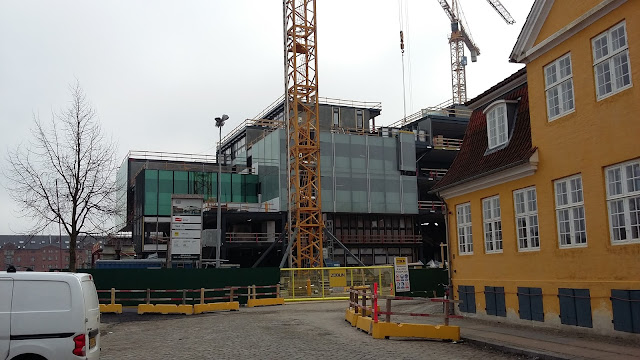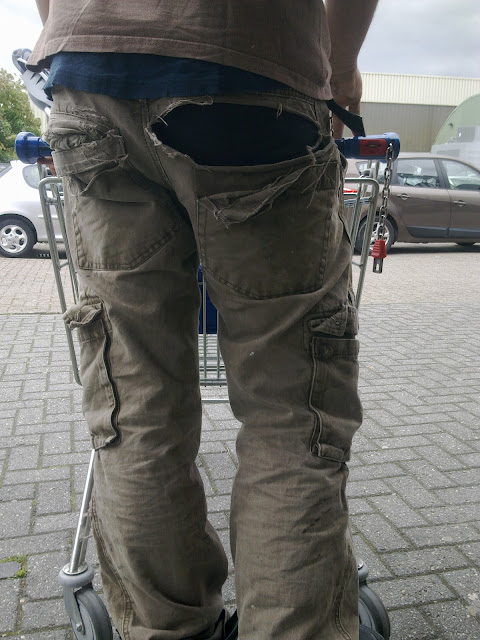copenhagen: an impression and a walk on the wild side

After three consecutive visits in as many years, it is safe to say we have established a small and important family tradition: my mother, my sister and I visit family and friends in Denmark for the duration of a long weekend in March. I believe I have mentioned this before and at the risk of boring you all over again, I must explain: my mum's from Denmark, born in Hellerup to be precise a suburb just north of Copenhagen and my dad's from the Netherlands, he was born in The Hague. They met in Denmark back in 195? when my dad was there on an AIESEC related student exchange - if I got my facts straight - after a tumultuous courtship they were married in 1961, she was the only one to emigrate. I think it's safe to say that mainly thanks to her, we have all kept in touch throughout the years. Perhaps emigrating does that to a person: wanting to keep family ties closely knit despite the distance.
In top pic: Copenhagen today: the old and the new. In the background we can see the construction of the Danish Architecture Centre, a design by Dutch architect Rem Koolhaas, a fact I find amusing as large parts of the old town centre were also redesigned and rebuilt by a Dutch architect in the early 17th century, who was commisioned by King Christian IV whose ambitions for urban development were quite grand indeed, hence the broad, open avenues throughout large parts of the city!
After lunch at our friend's house we had time to visit the National Museum
Whilst my mother and sister headed straight for the White Buses Exhibition, a WW2 related exhibit, I wandered even further into Denmark's history, starting with the Stone Age, moving gradually towards Viking modern day myths....
the descriptions in inverted comma's are all copied from the museum signs; the one below refers to the unclear image above, specifically number 2
'Lead amulet
with runes, Middle Ages, Østre Skovgård. The amulet
was found in 2008, folded as a small lump of lead and now, after being
unfolded, comprises a long strip of lead. The inscription on the outer side is
heavily corroded, but text fragments meaning ‘the holy spirit’ and ‘christ reigns’ can still be deciphered.
The text on the inner side contains magical litanies and incantations in
medieval Danish. All kinds of giants, elves, wicked trolls and evil were to be
kept away from the owner by the amulet, whose name was Ødmar or Ømar.'
oh my, to have such protection from all things evil; at any given moment of anxiety you can reach into your pocket, rub your fingers against the leaden talisman and be instantly reassured you are indeed secure and safe; how incredible this tiny object survived the centuries, was identified as being significant, unfolded and made intelligible for us today
 |
'Amber
figures are the only sculptural artworks from the Danish Stone age. Bears and
elks played an important role in the mythology of the hunters, and the figures
were worn as amulets.'
|
 |
| I forgot to document the age of these pieces of jewellery, all I know is they're not contemporary items, but they could easily be mistaken as such. |
I adore these tales of how we-of-olden-times viewed the goings-on in our surrounding world and tried to find explanations; of course the sun was worshipped and welcomed, as night was dark beyond anything we-of-the-modern-world are able to acknowledge, with our constant supply of light!
'Magician’s leather purse containing amulets and other magical items: the claw of a goshawk, a grass snake’s tail, a conch from the Mediterranean, a piece of a mussel shell, a small wooden cube, a small red stone, some dried roots, a fragment of an amber bead, small pebbles wrapped up in a piece of a pigeon’s gut, and the lower jaw of a young squirrel. The small pebbles and the squirrel’s remains may have been found in a hawk’s stomach the magician studied. Perhaps Bronze Age priests read omens in birds’ innards. 1300-1100 BC'
at the end of my tour I read this juicy tidbit 'In the 19th
century Denmark was in crisis. The Danish kingdom had been significantly reduced
by the loss of Norway (1814) and Southern Jutland (1864). Denmark needed a new
source of national pride. In folk culture the picture of Viking Age was
romanticised through literature and in everyday objects. It was also in the 19th
century that the concept of ‘the Viking
Age’ first appeared. The archaeologist J.A.A. Worsaae defined it, based on his research
on Scandinavian settlements on the British Isles and the excavations at Jylling
in 1861. Today the Viking has become a national symbol, and our view of the Vikings
is influenced by marketing, satire and exhibitions like VIKING.'
how delightful history can be reinvented to suit our needs.
 |
| Nationalmuseet/National Museum of Denmark on the outside |
 |
| Saturday evening we were invited by my cousin Alexandra for dinner in the café Traktorstedet situated in a new nature reserve Naturcenter Amager, she has recently landed a job there, hurray for her; together with a friend she'll be running the café close to the so-called Naturskolen. As you can see the landscape looks very similar to where I live: bog land! no wonder I feel at home (t)here: the three images above are in the reserve. Wonderful how it is only a couple of stops from Copenhagen's centre in the south-bound metro; you can just glimpse several tall appartment buildings in the Amager area. Back home below are some photo's I took yesterday whilst we were enjoying a gorgeous March Thursday; Django and I went for a walk from Fort Asperen through the villages of Acquoy (the name looks French however we pronounce the second syllable like the 'oy' in 'boy') and Gellicum, situated opposite each other along the river Linge. If you look closely you can spot the landscape in the Netherlands is slightly greener than in Denmark, down south Spring has sprung just that little bit earlier |







































Comments
and it's all so so so CLEAN looking....like not even
weeds
and all the buildings are so perfectly kept I love that they
choose Colours....
and really, i was happy to be back Home, too, with the Good Dog ahead.
Thank you for this, all of it, it opened OUT my day
ah yes Liz, popped over tou your place and saw why.
indeed Mo, magical indeed
Debbie, Bruges is nice of course, however Copenhagen....well it has everything you want in a city these days and more! a country rich with crafts(wo)men, artists, designers, you would be immensely inspired and rewarded for making the effort
opened up my HEAD, Grace!
I imagined you would, Dee (thanks)